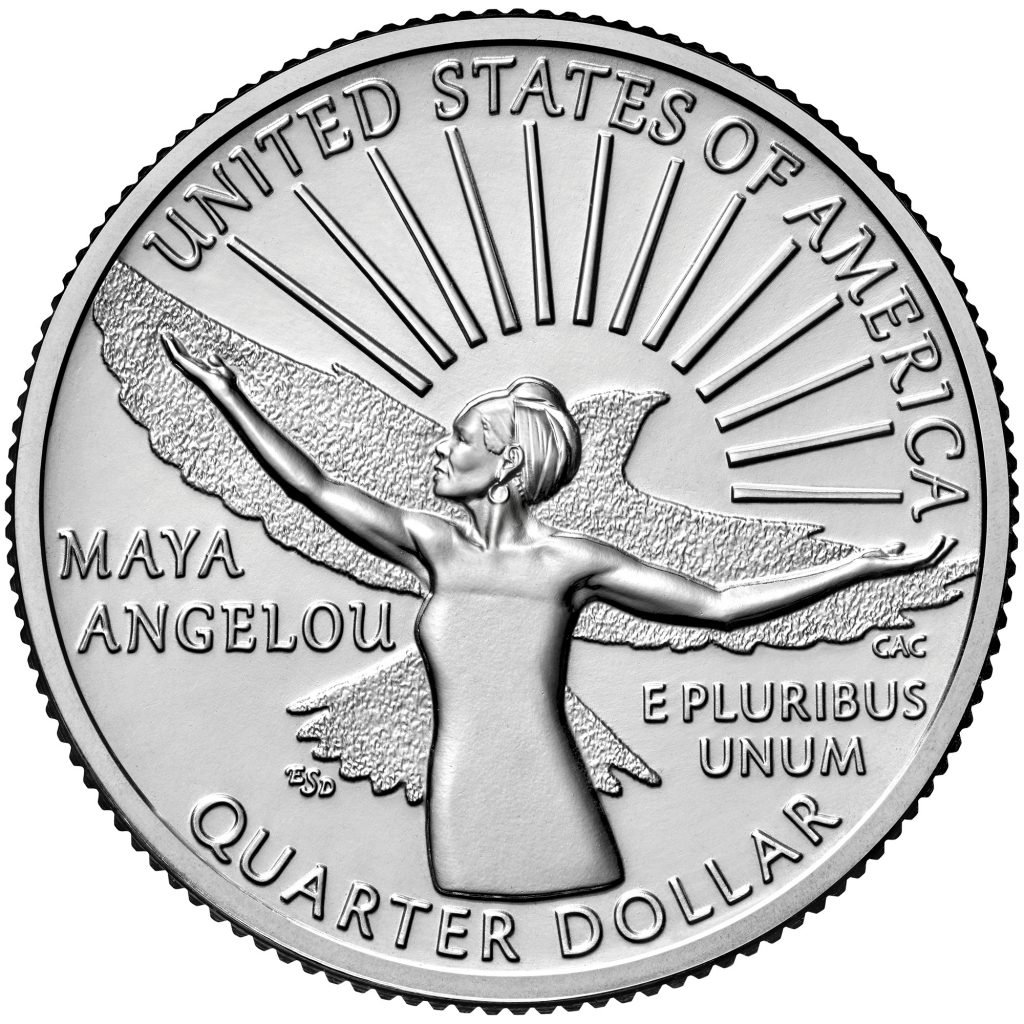The poet, writer, and activist Maya Angelou has become the first Black woman to appear on a U.S. quarter.
The U.S. Mint released a coin featuring her likeness into circulation earlier this week; the coin was created as part of the American Women Quarters Program, through which a series of special-edition coins honoring American women will be minted over the next four years. (Other women to be honored by the program this year include Chinese American film star Anna May Wong; astronaut Sally Ride; American Cherokee activist Wilma Mankiller; and suffragist Nina Otero-Warren.)
The quarter depicts a youthful Angelou with her arms outstretched, beams of sunlight haloing her. Her uplighting gesture is mirrored by the silhouette of a bird in flight behind her, which is a reference to Angelou’s widely read coming-of-age memoir I Know Why the Caged Bird Sings from 1969. The books details Angelou’s harrowing childhood growing up in the Jim Crow South.
The design, the Mint said in a statement, is “inspired by her poetry and symbolic of the way she lived.”
Angelou, who passed away in 2014 at the age of 86, is regarded as one of the most influential 20th-century American poets.
Wondering at the symbolism behind the depiction, we reached out to U.S. Mint artist Emily S. Damstra, who illustrated the design for Angelou’s coin as well as the forthcoming Anna May Wong quarter.

Design for the Maya Angelou quarter by Emily S. Damstra. Courtesy of the U.S. Mint.
You’ve depicted Maya Angelou with her arms upraised almost as though singing, and with a bird soaring behind her. Can you tell us how you came to this image?
It was a challenge to figure out a way to represent Maya Angelou, considering that her life and her contributions to American culture were so multifaceted. Ultimately, I decided that showing her in an uplifting stance, gesturing expressively, as she often did while performing, would best convey the passionate way she lived. The bird in flight and the rising sun are imagery that she incorporated in her own writing and are also symbolic of the way she lived.
The bird in my design is meant to embody the free bird in her poem “Caged Bird.” The bird I modeled the image on is is a purple martin, a songbird native to Arkansas, where Maya Angelou spent much of her childhood. Purple martins are aerial foragers that spend their days swooping and gliding high in the sky, catching insects on the wing. They are elegant birds in the same family as swallows. For those reasons I thought this would be a good species to illustrate Maya Angelou’s poem, however, the only thing that viewers need to understand is that it is a bird in flight; ultimately the species isn’t really important.
Did you base the depiction of Angelou on a specific photograph?
The image of Maya Angelou as a young woman is inspired by many of the photos I viewed, but the pose is entirely my own creation.
Do you have any favorite works by her?
My favorite piece of her writing is her first autobiography, I Know Why the Caged Bird Sings. Her series of autobiographies—starting with I Know Why the Caged Bird Sings—made a deep impression on me. I am in awe of her ability to recount her life in such detail, and her willingness to share her stories so honestly.
I know you’ve also made the design for the forthcoming Anna May Wong coin. How did you prepare for making that coin?
As part of my research, I watched one of her films and viewed many photos of her. She had a remarkable career and I’m so pleased that she’ll gain more recognition by being part of the American Women Quarters program.
Can you tell me about your career and how you came to designing coins?
My career started—and continues—as a natural science illustrator, but along the way, I began designing coins. As a dual citizen of Canada and the United States, I’ve had the privilege of working with both the Royal Canadian Mint (since 2010) and the United States Mint (since 2014) and designing coins and medals that celebrate the natural and cultural heritage of each country. I feel honored to see my work become a small part of the numismatic history of both countries. Thus far, I’ve created a few dozen designs for the Royal Canadian Mint and about a dozen designs for the United States Mint.
Can you tell us a little bit about the process of making the design and how you work with the sculptor who make the 3-D model for the coin?
My role in the coin design process is to research the theme I’ve been given and develop a design that honors the subject of the coin or medal. I follow some guidelines to ensure that my design is “coinable” and I try to define the elements clearly. My role ends once my two-dimensional design is finalized; then the sculptor takes over and turns it into a three-dimensional work of art.
Why do you think this project is important?
I am thrilled about the United States Mint’s new American Women Quarters program because the extraordinary women featured on the quarters deserve to be recognized for their achievements and their contributions to American life and culture!








